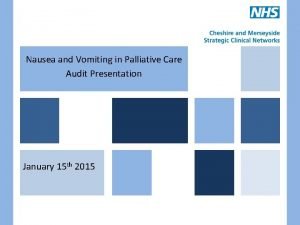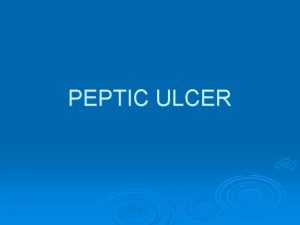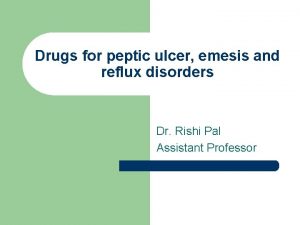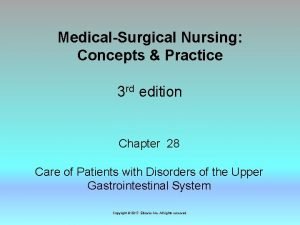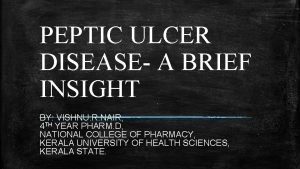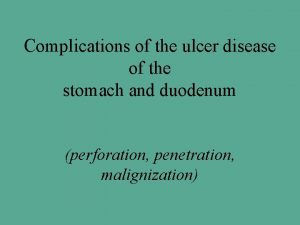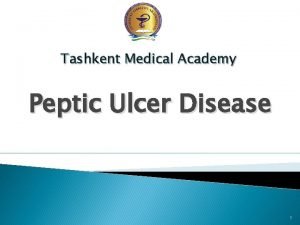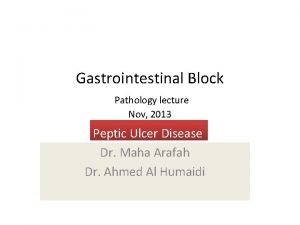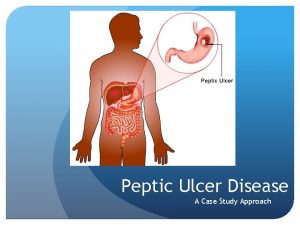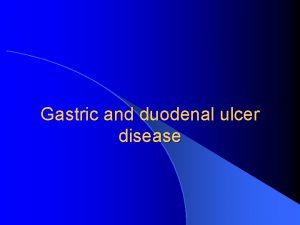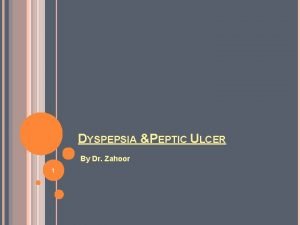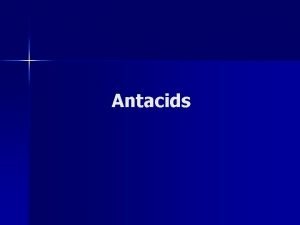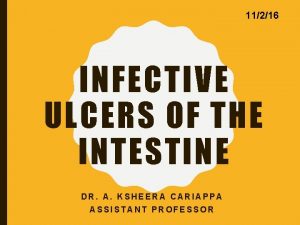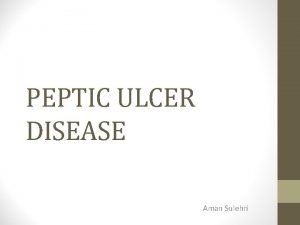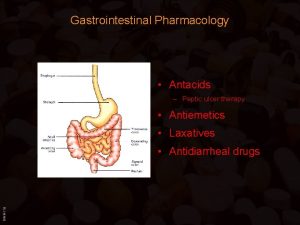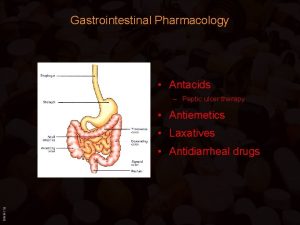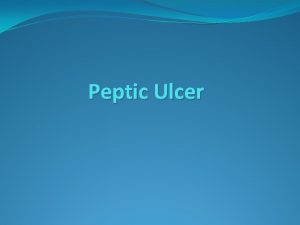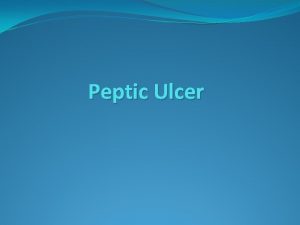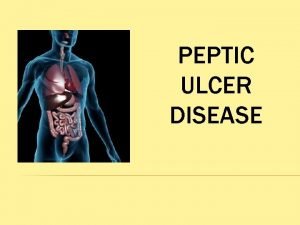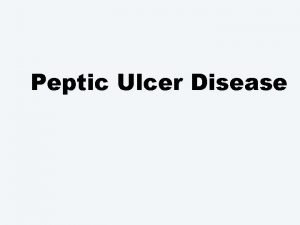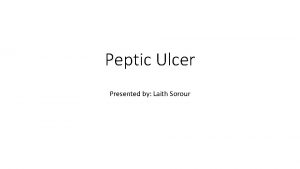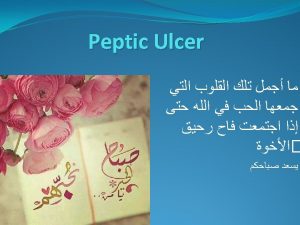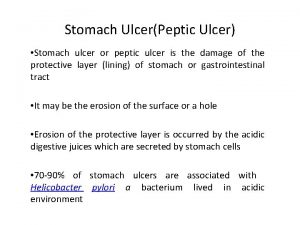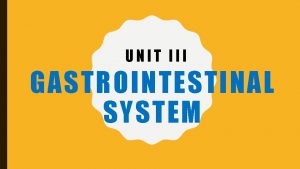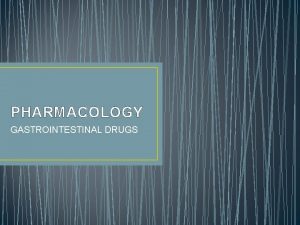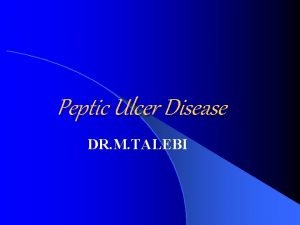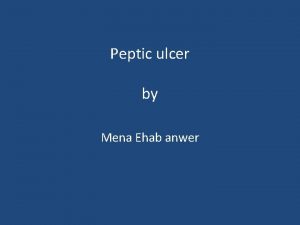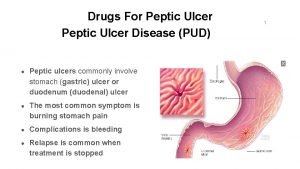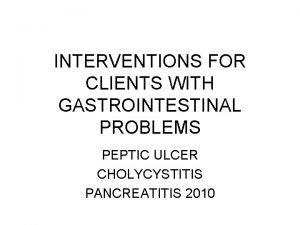Gastrointestinal Pharmacology Antacids Peptic ulcer therapy Antiemetics Laxatives



















- Slides: 19

Gastrointestinal Pharmacology • Antacids – Peptic ulcer therapy • Antiemetics • Laxatives BIMM 118 • Antidiarrheal drugs

Gastrointestinal Pharmacology Acid production: • • 2. 5 L per day Isotonic HCl solution p. H < 1 Produced by parietal cells Mucus production: BIMM 118 • • Produced by mucus-secreting cells Also produce bicarbonate, which becomes trapped in the mucus layer => p. H gradient across the mucus layer (can become destroyed by alcohol)

Gastrointestinal Pharmacology Antacids: Weak bases: • Aluminum hydroxide – Cause constipation • Magnesium hydroxide – Cause diarrhea => often combined BIMM 118 Usally taken 5 -7 times per day

Gastrointestinal Pharmacology Antacids: • • • Histamine stimulates acid production by parietal cells Mast cells produce a steady basal level of histamine, which increases in response to gastrin or acetylcholine Parietal cells express histamine H 2 receptors => H 2 receptor blockers: • Cimetidine (Tagamet®) – First H 2 -blocker available – Inhibits P 450 => Drug interaction • Ranitidine (Zantac®) – Does not inhibit P 450 => fewer side effects BIMM 118 • Nizatidine (Axid®) • Famotidine (Pepcid®)

Gastrointestinal Pharmacology Antacids: Proton pump inhibitors: – Irreversibly inhibit the H+/K+ - ATPase in gastric parietal cells – Drugs are inactive at neutral p. H, but since they are weak bases, are activated in the acidic stomach milieu => restricted activity – Acid production abliterated for 24 -48 hours BIMM 118 • • Omeprazole (Prilosec®) Lansoprazole (Prevacid®) Esomeprazole (Nexium®) Rabeprazole

Gastrointestinal Pharmacology Gastroesophageal reflux disease (GERD): BIMM 118 – Backflow of stomach acid into the esophagus – Esophagus is not equipped to handle stomach acid => scaring – Usual symptom is heartburn, an uncomfortable burning sensation behind the breastbone (MI often mistaken for GERD !) – More severe symptoms: difficulty swallowing, chest pain – Reflux into the throat can cause sore throat – Complications include esophageal erosions, esophageal ulcer and narrowing of the esophagus (esophageal stricture) – In some patients, the normal esophageal lining or epithelium may be replaced with abnormal (Barrett's) epithelium. This condition (Barrett's esophagus) has been linked to cancer of the esophagus. – Primary treatment option are proton pump inhibitors

Gastrointestinal Pharmacology Mucosal protective agents: • Misoprostol – Prostaglandin E 1 analog (PG stimulate mucus and bicarbonate production) – Used when treatment with NSAIDs inhibits endogenous PG synthesis • Sucralfate BIMM 118 – – Complex of aluminum hydroxide and sulfated sucrose Forms complex gels with mucus => mucus stabilized => diffusion of H+ impaired Not absorbed => essentially free of side effects Must be taken every 6 hours

Gastrointestinal Pharmacology Peptic Ulcer Disease Imbalance between defenses and aggressive factors • Defensive factors: Prevent the stomach and duodenum from self-digestion – Mucus: continually secreted, protective effect – Bicarbonate: secreted from endothelial cells – Blood flow: good blood flow maintains mucosal integrity – Prostaglandins: stimulate secretion of bicarbonate and mucus, promote blood flow, suppress secretion of gastric acid • Aggressive factors: BIMM 118 – Helicobacter pylori: gram negative bacteria, can live in stomach and duodenum, may breakdown mucus layer => inflammatory response to presence of the bacteria also produces urease – forms CO 2 and ammonia which are toxic to mucosa – Gastric Acid: needs to be present for ulcer to form => activates pepsin and injures mucosa – Decreased blood flow: causes decrease in mucus production and bicarbonate synthesis, promote gastric acid secretion – NSAIDS: inhibit the production of prostaglandins – Smoking: nicotine stimulates gastric acid production

Gastrointestinal Pharmacology Peptic Ulcer Disease (~25 mill. Americans will have an ulcer in their life) Most common cause (> 85%): Helicobacter pylorii (not stress or hot sauce!) Treatment options: BIMM 118 • • • Antibiotics Antisecretory agents Mucosal protectants Antisecretory agents that enhance mucosal defenses Antacids

Gastrointestinal Pharmacology Antibiotic ulcer therapy: Combinations must be used: • Bismuth (Pepto. Bismol®) – disrupts cell wall of H. pylori • Clarithromycin – inhibits protein synthesis • Amoxicillin – disrupts cell wall • Tetracyclin – inhibits protein synthesis • Metronidazole – used often due to bacterial resistance to amoxicillin and tetracyclin, or due to intolerance by the patient Standard treatment regimen for peptic ulcer: BIMM 118 Omeprazole + amoxicillin + metronidazole

Gastrointestinal Pharmacology Antiemetic drugs: Vomiting: – Infection, pregnancy, motion sickness, adverse drug effects, … – Triggered by the “vomiting center” or “chemoreceptor trigger zone (CTZ)” in the medulla (CTZ is on the ‘blood side’ of the blood-brain barrier). Treatment options: – – H 1 antagonists: Meclizine, promethazine, dimenhydramine… Muscarinic receptor antagonists: Scopolamine (motion sickness) Benzodiazepines: Lorazepam (during chemotherapy) D 2 antagonists: have also peripheral prokinetic effects => increase motility of the GI tract => increases the rate of gastric emptying. Caution in patients with Parkinson’s disease! Metoclopramide Domperidone BIMM 118 – Cannabinoids: Marihuana ? Synthetic cannabinoids: during chemotherapy Nabilone Dronabinol

Gastrointestinal Pharmacology Laxatives: • • Laxative – production of a soft formed stool over a period of 1 or more days Catharsis – prompt, fluid evacuation of the bowel, more intense Indications for laxative use: • • • Pain associated with bowel movements To decrease amount of strain under certain conditions Evacuate bowel prior to procedures or examinations Remove poisons To relieve constipation caused by pregnancy or drugs Contraindications: BIMM 118 • • • Inflammatory bowel diseases Acute surgical abdomen Chronic use and abuse

Gastrointestinal Pharmacology Laxatives: • • Stimulate peristalsis Soften bowel content Classification: • Bulk laxatives – Non-absorbable carbohydrates – Osmotically active laxatives • Irritant laxatives = purgatives – Small bowel irritants – Large bowel irritants BIMM 118 • Lubricant laxatives – Paraffin – Glycerol

Gastrointestinal Pharmacology Laxatives: Bulk laxatives: Increase in bowel content volume triggers stretch receptors in the intestinal wall => causes reflex contraction (peristalsis) that propels the bowel content forward Carbohydrate-based laxatives – – • • Insoluble and non-absorbable Non digestable; take several days for effect Expand upon taking up water in the bowel Must be taken with lots of water Vegetable fibers (e. g. Psyllium, lineseed) Bran (husks = milling waste product) Osmotically active laxatives BIMM 118 – Partially soluble, but not absorbable – Saline-based (mostly sulfates) – Effect in 1 -3 hrs => used to purge intestine (e. g. surgery, poisoning) • • Mg. SO 4 (= Epsom salt) Na 2 SO 4 (= Glauber’s salt)

Gastrointestinal Pharmacology Laxatives: Irritant laxatives: Cause irriatation of the enteric mucosa => more water is secreted than absorbed => softer bowel content and increased peristaltic due to increase volume Small bowel irritants • Ricinoleic acid (Castor oil) – Active ingredient of Ricinus communis – The oil (triglyceride) is inactive – Ricinoleic acid released from oil through lipase activity BIMM 118 Ricin: – Lectin from the beans of R. communis – Potent toxin: inhibits protein synthesis – Potential bioterrorism agent (LD ~100 mg) In 1978, ricin was used to assassinate Georgi Markov, a Bulgarian journalist who spoke out against the Bulgarian government. He was stabbed with the point of an umbrella while waiting at a bus stop near Waterloo Station in London. They found a perforated metallic pellet embedded in his leg that had presumably contained the ricin toxin.

Gastrointestinal Pharmacology Laxatives: Irritant laxatives: Large bowel irritants Anthraquinones BIMM 118 Active ingredient of Senna sp. (Folia and fructus sennae), Rhamnus frangulae (cortex frangulae) and Rheum sp. (rhizoma rhei): contain inactive glycosides => active anthraquinones released in colon take 6 -10 hours to act

Gastrointestinal Pharmacology Laxatives: Irritant laxatives: Large bowel irritants Diphenolmethanes – Derivatives of phenolphtalein • Bisacodyl – Oral administration: effect in 6 -8 hrs – Rectal administration: effect in 1 hr – Often used to prepare for intestinal surgery BIMM 118 • Sodium picosulfate

Gastrointestinal Pharmacology Laxative abuse: Most common cause of constipation! – Longer interval needed to refill colon is misinterpreted as constipation => repeated use BIMM 118 – Enteral loss of water and salts causes release of aldosterone => stimulates reabsorption in intestine, but increases renal excretion of K+ => double loss of K+ causes hypokalemia, which in turn reduces peristalsis. This is then often misinterpreted as constipation => repeated use

Gastrointestinal Pharmacology Antidiarrheal drugs: treat only symptoms! – Diarrhea is usually caused by infection (Salmonella, shigella, campylobacter, clostridium, E. coli), toxins, anxiety, drugs… – In healthy adults mostly discomfort and inconvenience – In children (particularly mal-nourished) a principal cause of death due to excessive loss of water and minerals. Antimotility agents: – Muscarinic receptor antagonists (not useful due to side effects) and opiates: • Morphine • Codeine • Diphenoxylate – All have CNS effects - NOT useful for diarrhea treatment • Loperamide BIMM 118 – – Selective action on the GI tract Does not produce CNS effects First choice antidiarrheal opoid Combined with Dimethicone (Silicon-based gas-absorbent)
 Anatomy of ulcer
Anatomy of ulcer Triple therapy for peptic ulcer disease
Triple therapy for peptic ulcer disease Triple therapy for peptic ulcer disease
Triple therapy for peptic ulcer disease Ondansetron palliative care
Ondansetron palliative care Peptic ulcers causes
Peptic ulcers causes Dicycloamine
Dicycloamine Ajeerna symptoms
Ajeerna symptoms Nursing management of peptic ulcer
Nursing management of peptic ulcer Patient counselling for peptic ulcer disease
Patient counselling for peptic ulcer disease Stages of peptic ulcer perforation
Stages of peptic ulcer perforation What causes stomach ulcers
What causes stomach ulcers Gastric ulcer
Gastric ulcer Peptic ulcer case study
Peptic ulcer case study Gastric ulcer vs duodenal ulcer
Gastric ulcer vs duodenal ulcer Peptic ulcer disease
Peptic ulcer disease Peptic ulcer diseas
Peptic ulcer diseas Antacids side effects
Antacids side effects Tea pot stomach seen in
Tea pot stomach seen in Typhoid ulcer gross
Typhoid ulcer gross Classification of ulcer
Classification of ulcer



